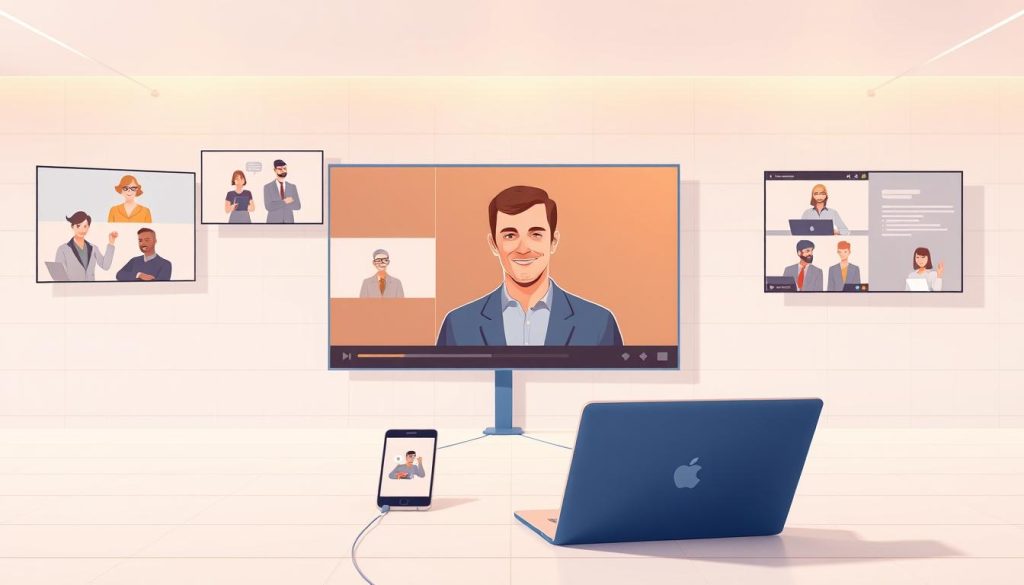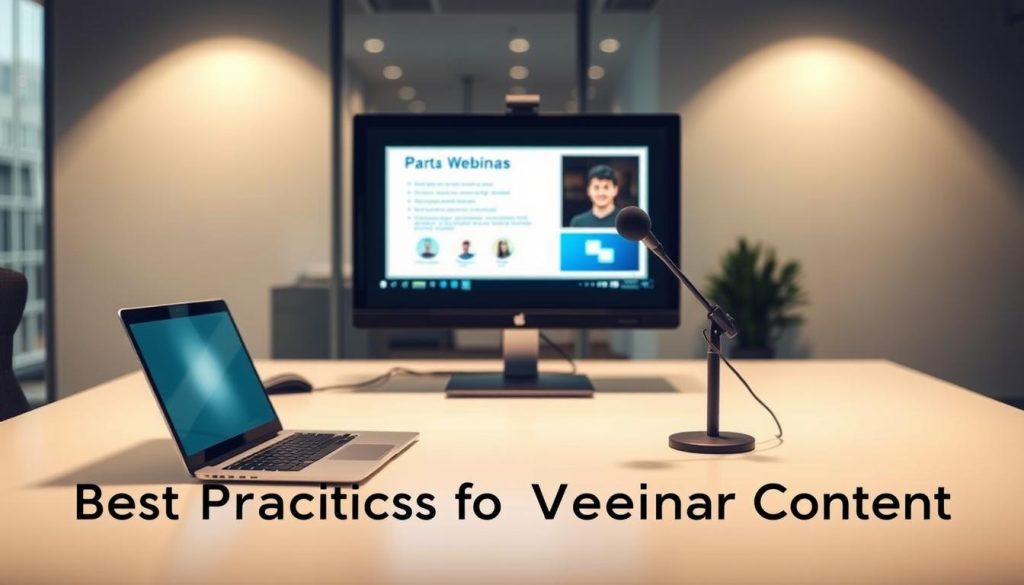We help you leverage the power of webinar strategies to boost your online course sales. By connecting with prospects in real-time, building rapport and authority, and making a persuasive pitch, you can significantly increase your revenue.
Our approach focuses on delivering value and showcasing your expertise, converting attendees into paying students. With effective online course promotion, you can reach a wider audience and drive sales.
Key Takeaways
- Leverage webinar strategies to boost online course sales
- Build rapport and authority with prospects in real-time
- Deliver value and showcase your expertise
- Convert attendees into paying students
- Reach a wider audience with effective online course promotion
Understanding Webinar Marketing and Its Benefits
The rise of virtual event marketing has led to webinar marketing becoming a crucial component of digital marketing strategies for online courses. As a result, we’re seeing a significant shift in how educators and course creators approach their marketing efforts.

What is Webinar Marketing?
Webinar marketing involves using webinars as a tool to promote and sell online courses. It’s a strategy that allows educators to connect directly with potential students, build trust, and demonstrate their expertise. By hosting webinars, course creators can provide value upfront, showcasing what their courses offer and how they can help solve specific problems for their audience.
Effective webinar marketing is about more than just hosting a presentation; it’s an interactive experience that engages the audience and encourages participation. This can include Q&A sessions, live demonstrations, and interactive polls, all designed to create a more immersive experience.
The Advantages of Using Webinars for Courses
Using webinars for course marketing offers several advantages. Firstly, webinars allow for real-time interaction with potential students, helping to build a community around your course offerings. Secondly, they provide an opportunity to showcase your expertise and establish credibility in your field. Lastly, webinars can significantly improve conversion rates, with click-through rates for webinar offers ranging between 15-20%, and high performers seeing rates as high as 30% and above.
By leveraging webinar marketing, course creators can not only drive sales but also gather valuable feedback from their audience, helping to refine their course content and marketing strategies. As part of a broader digital marketing strategy, webinar marketing can be a powerful tool for achieving long-term success in the online education market.
Choosing the Right Webinar Format
Selecting the right webinar format is crucial for the success of your online course sales. The choice between different formats depends on your goals and target audience.
We need to consider several factors when deciding on a webinar format. These include the level of interaction, the type of content, and the audience’s preferences.
Live vs. Recorded Webinars
Live webinars offer real-time interaction and can create a sense of urgency. They are ideal for launching new courses or promoting limited-time offers.
Recorded webinars, on the other hand, provide flexibility and can be used for evergreen content. They allow potential customers to learn at their own pace.
Key considerations for live webinars:
- Technical requirements for live streaming
- Engagement strategies to keep the audience involved
- Rehearsals to ensure a smooth delivery
Benefits of recorded webinars:
- Flexibility for the audience
- Evergreen content that can be used multiple times
- Reduced pressure on the presenter
Interactive Webinars vs. Presentation-Style
Interactive webinars incorporate elements like polls, Q&A sessions, and gamification to engage the audience. They are effective for building a community around your course.
Presentation-style webinars are more straightforward and focus on delivering content in a clear and concise manner. They are suitable for complex topics that require detailed explanations.

For more insights on choosing the perfect webinar format, we recommend checking out this guide on webinar formats.
By understanding the strengths of each webinar format, we can create a strategy that aligns with our goals and audience needs, ultimately boosting our online course sales.
Crafting Compelling Webinar Topics
Understanding your audience’s pain points is the first step in creating a webinar topic that drives engagement and conversions. We need to identify what challenges your audience is facing and tailor your webinar content to address these issues effectively.
Identifying Your Audience’s Pain Points
To craft a compelling webinar topic, we must first understand the needs and concerns of our target audience. This involves conducting thorough market research and analyzing feedback from potential attendees. By doing so, we can create a topic that resonates with their interests and needs.
Some effective ways to identify pain points include:
- Conducting surveys and polls to understand audience concerns
- Analyzing social media discussions related to your course topic
- Reviewing feedback from previous webinars or customer support queries
How to Align Topics with Course Offerings
Once we have identified our audience’s pain points, we need to align our webinar topic with our course offerings. This ensures that the webinar content is relevant and valuable to the attendees, and it also serves as a precursor to promoting our online courses.
To achieve this alignment, we should:
- Map the webinar topic to the core themes of our course
- Ensure that the webinar provides actionable insights that complement the course material
- Use the webinar as an opportunity to showcase our expertise and build trust with potential customers
For more insights on creating successful webinars, check out our ultimate guide to building great webinars to increase sales.
By following these strategies, we can create webinar topics that not only attract attendees but also effectively promote our online courses, leveraging webinar advertising techniques and digital marketing for courses to maximize our reach and impact.
Hosting Engaging Webinars
In the realm of online education marketing, hosting engaging webinars is a game-changer. We have found that interactive and immersive webinar experiences significantly boost audience engagement and, ultimately, online course sales.
To host a successful webinar, we need to focus on two critical aspects: the right tools and technology, and the ability to captivate our audience.
Essential Tools and Technology for Successful Webinars
Having a well-equipped tech stack is essential for hosting successful webinars. This includes:
- Reliable internet connectivity
- High-quality webcam and microphone
- Presentation software with interactive features
- Engagement tools such as polls, Q&A sessions, and chat boxes
By leveraging these tools, we can create an engaging and interactive experience for our audience. For instance, using presentation software with interactive features allows us to keep our audience engaged through live polls and Q&A sessions.

Tips for Captivating Your Audience
Captivating our audience is crucial for the success of our webinar. Here are some tips to achieve this:
- Start with a strong, engaging introduction that sets the tone for the webinar.
- Use storytelling techniques to make the content more relatable and interesting.
- Incorporate interactive elements throughout the webinar to keep the audience engaged.
- Provide valuable insights and actionable tips that our audience can apply.
By following these tips and utilizing the right tools and technology, we can host webinars that not only engage our audience but also drive sales for our online courses. Effective webinar strategies are key to successful virtual event marketing.
Driving Registrations for Your Webinar
Webinar marketing for online course sales hinges on effective registration strategies. To drive registrations, we need to leverage multiple marketing channels and optimize our landing pages for conversions.
Effective Marketing Channels for Promotion
We use a combination of social media, email marketing, and content marketing to promote our webinars. Social media platforms like Facebook, LinkedIn, and Twitter are invaluable for reaching a broad audience. For instance, Facebook’s targeted advertising allows us to reach potential registrants based on their interests, behaviors, and demographics.
Email marketing remains a powerful tool for promoting webinars, especially when we segment our email list to target specific groups with tailored messages. Personalization is key here; using the recipient’s name and referencing their previous interactions with our content can significantly boost engagement.

Optimizing Landing Pages for Conversions
An effective landing page is crucial for converting visitors into registrants. Clear and concise messaging is vital; the page should immediately communicate the value of the webinar and what attendees can expect to learn.
As
“The most successful webinars are those that clearly communicate their value proposition and make registration easy.”
Optimizing landing pages involves A/B testing different elements like headlines, call-to-action (CTA) buttons, and images to see what works best.
To maximize conversions, our landing pages should have a simple design, a prominent CTA, and minimal distractions. Mobile optimization is also critical, as a significant portion of users will access our landing page via mobile devices.
- Use a clear and compelling headline that communicates the webinar’s topic and value.
- Include a prominent call-to-action (CTA) button that stands out on the page.
- Minimize form fields to reduce friction and increase registrations.
- Use social proof, such as testimonials or the number of registrants, to build credibility.
Best Practices for Webinar Content
To maximize the impact of your webinar, it’s crucial to focus on creating engaging content that resonates with your audience. A well-structured webinar with interactive elements can significantly boost engagement and conversion rates.
As we discussed in previous sections, webinar strategies play a vital role in increasing course sales. Now, let’s dive into the specifics of creating compelling webinar content.
Structuring Your Webinar: Beginning, Middle, and End
A successful webinar requires a clear structure to keep your audience engaged. This includes a captivating introduction, an informative main body, and a strong conclusion.
- Begin with a hook to grab the audience’s attention.
- Use the main body to deliver valuable content and insights.
- End with a clear call-to-action, guiding your audience on the next steps.
As Neil Patel once said, “Content is king, but distribution is queen, and she rules the castle.” Effective webinar content distribution involves engaging your audience throughout the presentation.
“The key is not to prioritize what’s on your schedule, but to schedule your priorities.” –
Incorporating Interactive Elements
Incorporating interactive elements is crucial for maintaining audience engagement. This can include:
- Quizzes and assessments to test knowledge.
- Q&A sessions to address audience queries.
- Live polls to gather feedback and encourage participation.
By incorporating these elements, you can create a more immersive experience, increasing the chances of converting attendees into customers. As seen in the image below, interactive webinars can lead to higher engagement rates.

To further enhance engagement, consider stoking FOMO (Fear of Missing Out) by offering limited-time offers or exclusive content. This can be a powerful webinar conversion tactic, driving sales and increasing revenue.
Following Up After the Webinar
After the curtains close on your webinar, the real show begins with strategic follow-ups. We understand that the true potential of a webinar is realized after it ends, through effective follow-up strategies that nurture leads and drive conversions.
Effective post-webinar engagement is crucial for maximizing the return on investment (ROI) from your online education marketing efforts. It’s about building on the momentum generated during the webinar and guiding attendees toward the next step in their customer journey.
Importance of Post-Webinar Engagement
Engaging with attendees after a webinar is vital for several reasons. Firstly, it helps in reinforcing the value proposition presented during the webinar, keeping your brand top of mind for potential customers. Secondly, it provides an opportunity to gather feedback, understand attendee needs better, and identify areas for improvement in future webinars.
Some key reasons why post-webinar engagement is important include:
- Increasing the chances of converting leads into sales by maintaining a consistent dialogue.
- Enhancing the overall customer experience by providing additional value through resources and support.
- Building a community around your brand, fostering loyalty, and encouraging word-of-mouth marketing.
Strategies for Nurturing Leads
Nurturing leads after a webinar involves a combination of personalized communication and strategic content sharing. Here are some effective strategies:
- Follow-up Emails: Send a series of emails that provide additional resources, answer common questions, and gently guide leads toward a sales conversation.
- Exclusive Content: Offer webinar attendees exclusive content, such as eBooks, whitepapers, or case studies, that add value and deepen their understanding of your course offerings.
- Surveys and Feedback: Request feedback through surveys to understand attendee satisfaction and identify opportunities to improve future webinars.
- Retargeting Ads: Utilize retargeting ads on social media and other platforms to keep your brand in front of attendees who may not have converted immediately.
By implementing these strategies, we can significantly enhance the effectiveness of our webinar conversion tactics, turning attendees into loyal customers and advocates for our digital marketing for courses.

Analyzing Webinar Success
To gauge the true impact of your webinar marketing efforts, it’s crucial to analyze its success comprehensively. This involves delving into various metrics and leveraging the right tools to understand your webinar’s performance.
Key Metrics to Measure Effectiveness
Tracking key metrics is essential for understanding the effectiveness of your webinar. Some of the crucial metrics include registration rates, attendance rates, and conversion rates. Registration rates indicate the initial interest in your webinar, while attendance rates show the actual engagement. Conversion rates, perhaps the most critical metric, reveal how many attendees took the desired action, such as purchasing your online course.
By analyzing these metrics, we can identify areas of improvement for future webinars. For instance, if the registration rate is high but the attendance rate is low, it may indicate that the webinar topic was appealing, but the follow-up reminders or the timing wasn’t optimal.
Tools for Tracking Webinar Performance
Utilizing the right tools is vital for tracking webinar performance effectively. Webinar platforms like Zoom, GoToWebinar, and Demio provide analytics on registration, attendance, and engagement. Additionally, integrating analytics software can offer deeper insights into attendee behavior and conversion rates.
By combining the data from these tools, we can gain a comprehensive understanding of our webinar’s impact and make informed decisions to enhance future webinar strategies. This data-driven approach is crucial for optimizing webinar marketing for online course sales and improving overall online course promotion.
Scaling Webinar Marketing for Long-Term Success
To maximize the impact of your webinar marketing efforts, we need to think beyond a single event. By repurposing webinar content and building a webinar series, we can create a sustainable online education marketing strategy that drives ongoing engagement and boosts online course sales.
Maximizing Content Value
Repurposing webinar content is crucial for getting the most out of our virtual event marketing efforts. We can turn webinars into evergreen content by converting them into blog posts, social media content, or even video series. This approach helps us reach a broader audience and reinforces our message across multiple channels, enhancing our webinar advertising techniques.
Creating Ongoing Engagement
Building a webinar series allows us to maintain a consistent dialogue with our audience, fostering a community around our online courses. By planning a series of webinars on related topics, we can keep our audience engaged over time, providing ongoing value and nurturing leads through the sales funnel, ultimately driving long-term success in online education marketing.
